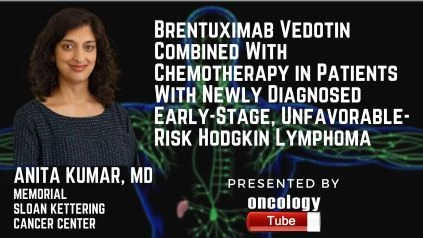Anita Kumar, MD from Memorial Sloan Kettering Cancer Center speaks about Brentuximab Vedotin Combined With Chemotherapy in Patients With Newly Diagnosed Early-Stage, Unfavorable-Risk Hodgkin Lymphoma.
Link to Article:
https://ascopubs.org/doi/full/10.1200/JCO.21.00108?bid=90385523&cid=DM8089
Summary –
Intention:
Improve the prognosis for newly diagnosed early-stage (ES) unfavorable-risk Hodgkin lymphoma and reduce long-term side effects.
Methodologies:
Patients were given four cycles of brentuximab vedotin (BV) plus doxorubicin, vinblastine, and dacarbazine in this multicenter trial with four consecutive cohorts (AVD). Patients were given 30-Gy involved-site radiation in cohort 1, 20-Gy involved-site radiotherapy in cohort 2, 30-Gy consolidation-volume radiotherapy in cohort 3, and no treatment in cohort 4 if PET-4 was negative. Patients with ES and unfavorable-risk disease were eligible. Bulk disease, as defined by Memorial Sloan Kettering criteria (maximum transverse or coronal width more than 7 cm on computed tomography), was not needed for cohorts 1 and 2, but was required for cohorts 3 and 4. The primary endpoints were to assess cohort 1’s safety and cohorts 2-4’s full response rate by PET.
Outcomes:
With a median age of 32 years, 116 patients completed chemotherapy: 50 percent men, 98 percent stage II, 86 percent Memorial Sloan Kettering disease bulk, 27 percent traditional bulk (> 10 cm), 52 percent elevated erythrocyte sedimentation rate, 21 percent extranodal involvement, and 56 percent > 2 involved lymph node sites. In cohorts 1-4, the complete response rate was 93 percent, 100 percent, 93 percent, and 97 percent, respectively. The overall 2-year progression-free and overall survival rates were 94 percent and 99 percent, respectively, with a median follow-up of 3.8 years (5.9, 4.5, 2.5, and 2.2 years for cohorts 1-4). The 2-year progression-free survival rates in cohorts 1-4 were 93 percent, 97 percent, 90 percent, and 97 percent, respectively. Neutropenia (44%) was the most common adverse event, followed by febrile neutropenia (8%), and peripheral neuropathy (54%) that was mostly reversible.
Conclude:
For ES, unfavorable-risk Hodgkin lymphoma, including bulky disease, BV + AVD four cycles is a very aggressive and well-tolerated therapy regimen. The safety of reducing or eliminating consolidative radiation in PET-4–negative patients is supported by the effectiveness of BV + AVD.

